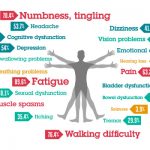![]()
When you have a disease like Multiple Sclerosis (MS), exercise becomes a necessity. Physical activity has many benefits, but when planning a program, do so with care and wisdom. The exercises you choose should focus on your specific needs. A trained and experienced physiotherapist will help you in this regard. He or she will evaluate your strengths and weaknesses and know your limitations and will then devise a program accordingly.
Contact us if you need a physiotherapist to help you with MS
A physically active lifestyle can reduce the progress of the disease. In a study conducted by the Ohio State University, researchers found that a person who was physically fit had less damage in parts of the brain which were deteriorated due to MS. Physical Exercise also helps boost wellness with MS.
We have a set of exercises for our readers who have MS.
Strengthening Exercises
- Wall Squats for Strength Training
Many MS patients have balance problems. One of the reasons is weak legs, especially weak thigh muscles. Wall squats are best for strengthening leg muscles, especially the quadriceps, those present at the front of your thighs, and hamstring muscles, present at the back of your thighs.
Wall squats or wall sits are not very complicated. Follow these steps so that you do the exercise with correction.
- Lean against the wall with your feet planted firmly on the ground, shoulder width apart. Keep your legs straight and feet two feet from the wall.
- Slide down the wall with your back pressed against it until your legs are parallel to the ground and your shins and thighs make a ninety degree angle.
- Make sure that your knees are above your ankles and your back is touching the wall.
- Hold the position for as long as your strength allows, twenty seconds to a minute. Then pull yourself up to the position where you had started.
- Count to ten and repeat.
- Start from one set of three reps. You can also start from 3 sets of 3 reps if your strength allows.
- As you gain strength, increase your holding time by 10 seconds.
Note: It’s normal to feel a burning sensation in the quadriceps muscles. However, if you feel even slight pain in your knee or kneecap, stop the activity immediately.
Benefits
- Doing wall sits increases the strength and endurance of the rectus femoris muscle. This muscle helps to move your thigh and torso closer.
- Builds your strength and endurance in glutes, calves and quadriceps.
- Planks for Core Strengthening
You can work on your core muscles with this exercise. Planks strengthen your abdominals, the obliques, and the back, says Kelly Bonner, an exercise physiologist and information specialist at NCHPAD.
- Lie on the floor or an exercise mat with your face down.
- With your feet slightly apart, lift your entire body on your forearms, elbows and toes.
- Keep your body straight from the crown of your head to your toes.
- Elbows should be directly under your shoulders.
- Tilt your pelvis and contract your abdominal muscles to prevent your rear from sticking up.
- Count to 30, then return to the starting position and rest for 10 to 15 seconds.
- Repeat three to five times. Increase the counts by 10 as you get stronger.
- Modified Planks for Safer Core Strengthening
Try modified planks, if simple planks are difficult for you. They are similar to the modified push-ups.
- Lie on the floor or an exercise mat with your face down.
- You don’t want your elbows and knees to pain, so prop yourself up on those.
- Keep your body straight from the crown of your head through your torso to your knees.
- Hold the position for twenty seconds to a minute.
- Count to ten and repeat.
The difference between traditional planks and modified planks is that you rest on your toes in planks, but you rest on your knees in modified planks.
As you gain strength, you can shift to traditional planks.
- Wall Push-ups for Upper-body strengthening
Wall push-ups are good to build strength in your triceps, pectorals, and deltoids
- Stand or sit facing a wall.
- Keep your feet together and two feet away from the wall.
- Place your hands flat on the wall. Make sure that your arms are at shoulder height, straight out and slightly more than shoulder-width apart.
- Lean toward the wall, keeping your elbows tucked in to your sides, until your nose almost touches it.
- Hold this position and focus on your posture.
- You should feel a slight stretch in your calves (if standing) and in your upper chest. Make sure that your body is in a straight line from head to toe if you’re standing or your back is straight if you’re seated.
- Slowly return to your starting position.
- Repeat three to five times and increase as you gain more strength.
- Overhead Press for Upper-Body Strengthening
MS patients should not only strengthen their lower-body, but they must also work on their upper-body. The stronger the upper-body, the easier everyday tasks become to do. Here’s how to do overhead press.
- Stand or sit with good posture, making sure to keep your head up and back straight.
- Start with both arms out to the side, elbows bent and hands at about ear height.
- Using some light dumbbells or soup cans, extend your arms up, above your head so that your biceps are close to your ears.
- Bring them back down to the starting position.
- Work up to 10 consecutive reps.
- Lunges for Lower-Body Strengthening
Lunges not only strengthen your quads, ankles, and hamstrings but also improve your balance. If you are doing lunges for the first time, we advise you to do it near a piece of furniture or any other object that you can use for support if you feel.
This is what you should do:
- Step forward with one leg, dropping the opposite knee until it’s a couple of inches from the ground. Your front leg will also bend at the knee. Both knees should be at about a 90-degree angle.
- Return to the upright position and switch legs.
- Do this 10 times with each leg.
Stretching Exercises
- Lying Knee Hold
It is a good exercise to stretch your hip and lower-back muscles.
- Lie on your back, with your arms at your sides and your legs straight.
- Pull one knee up to your chest, keeping the other leg stretched out.
- Try to keep your knee as close to your chest, but don’t push hard.
- Return to the beginning position, and then repeat with the other leg.
- Repeat 10 times on each leg.
- The Bridge
People develop problems in their lower-backs; bridge is a great exercise to condition that region. The lower-back bridge is also good for conditioning glutes, legs, and abdominal muscles. Here’s how to do this exercise:
- Lie on your back, with your arms at your sides and your legs straight.
- Bring your feet in toward your butt, keeping your feet flat on the floor.
- Contract your stomach muscles, pulling your belly button in toward your spine.
- Lift your hips by tightening your butt muscles and exhale. At the top of the movement, your body should form a diagonal line from your knees to your chest.
- Hold for 10 to 15 seconds and then inhale as you return to the starting position.
- Work up to 10 to 12 repetitions.
Balance Improving Exercises
You can exercise to improve your balance. Do each exercise for 2-4 minutes, then gradually increase the duration.
- Feet together Balance
Follow these steps to properly do the exercise
- While standing, keep your feet closer to each other.
- Try to stay in the position as you balance yourself without holding anything.
Heel to toe Balance
This exercise is a little variation of the ‘feet together balance’.
- While standing, touch the toe of one leg with the heel of your other foot.
- Try to stay in the position as you balance yourself.
- Hold any piece of furniture or wall if you feel hard to balance without holding anything.
- Marching in Place
This exercise is beneficial for people who have balancing and walking problems and weakness in their legs. Marching in place improves mobility and reduces the risk of falling. The person doing this exercise shifts their body weight from side to side, thereby challenging their balance.
Here’s how to do Marching in Place:
- Stand with your feet hip-width apart, abdominal muscles firm. If needed, use a counter or chair to steady yourself.
- Slowly bend your right knee, raising your right foot off the floor, and bring your leg to a marching position. Your thigh should be about parallel to the floor.
- Pause for three seconds and then slowly lower the leg.
- Repeat with your left leg.
- Continue until you’ve completed five repetitions, then switch to your right leg.
- Work up to 10 to 15 repetitions with each leg.
Do these exercises and home and share your experience in the comments below. Ask someone to help you or stand close by as you do the exercises.
Don’t forget to check some of our earlier posts related to exercise with MS:
- Sitting Exercises
- 30 Days Exercise Challenge!
- Top 10 Exercise Tips for MS Patients
- Boost Wellness with Physical Exercises







[…] To improve your balance and coordination, you may want to start easy exercises for MS patients. […]